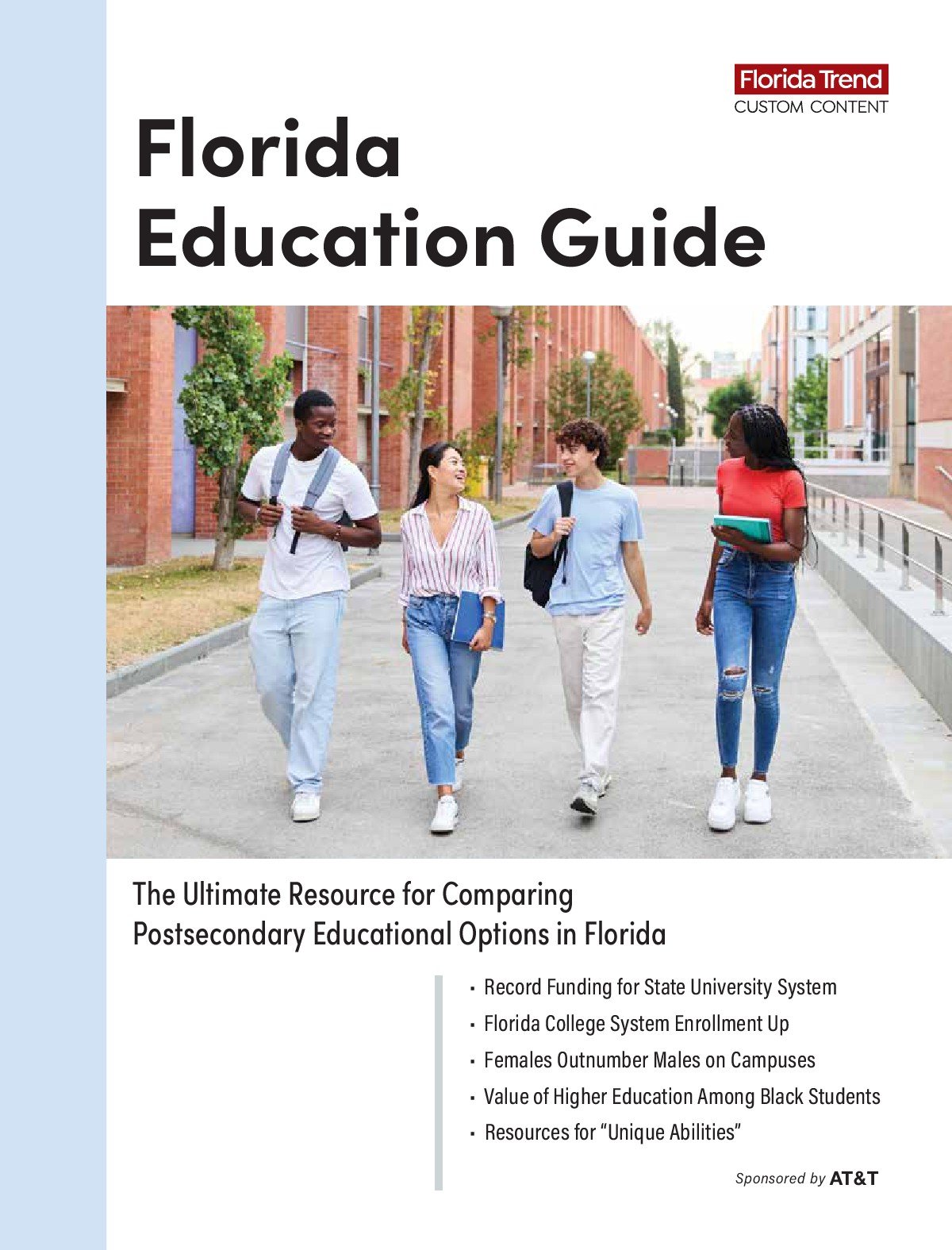An apartment development unlike any other in Florida takes shape east of the Orange County Convention Center. Catchlight Crossings will total 1,000 units and have resort-style pools, a fitness center, a game room, technology cafes, bike and walking paths, a community garden, medical offices and a tuition-free, Montessori-inspired Bezos Academy pre-school.
Fine amenities, true, but not unique. What stands out is that Catchlight units will carry below-market rents and be reserved for households earning as little as 60% of the area median income and no more than 120% — about $81,120 for an individual, sliding upward based on the number of family members. Even more unusual is Catchlight’s landowner and master developer: theme park company Universal Destinations & Experiences.
Universal and its not-for-profit Housing for Tomorrow conceived the project, provided its 20-acre site and hired Altamonte Springs-based affordable housing developer Wendover Housing Partners to birth the development and operate it in perpetuity as affordable rental housing for any qualified renter, including Universal employees.
“Affordable housing is one of the region’s most pressing issues, and Catchlight Crossings reinforces our commitment to be part of the solution and give back to the community that we have called home for more than 30 years,” says John Sprouls, executive vice president and chief administrative officer for Universal Destinations & Experiences. “Our vision has been to bring an innovative new approach to solving our community’s affordable housing crisis. This is about creating a community that will put residents first — a place that inspires them and that they will be proud to call home.”
One in three households
Housing affordability is an issue across the nation, though a relatively newer issue in Florida. The state once enjoyed an edge over other parts of the country when it came to home prices and rent. A decade ago, the ratio of median home price to median income was better in Miami than in New York, Boston and Seattle.
That advantage has disappeared. Higher rents and house prices are not only hard on renters and home buyers but also impact employers in recruitment and retention. High housing costs form a barrier to Florida’s economic growth, the Florida Council of 100 business executive group said in a January report. In 2023, the state had the highest percentage of cost-burdened renters — households spending more than 30% of income on rent — in the nation, the report says. More distressing: Nearly one in three Florida households were “severely burdened” — that is, spending more than half their income on rent — the highest percentage of such renter households in the nation, the business group says.
Blame a combination of factors, starting with rapid migration and immigration and the resulting demand for houses and rental units pushing up prices. The U.S. Census reports Florida gained a net 249,064 people in 2022, the most in the nation. As the economy weakened in recent years, price appreciation slowed but didn’t retreat. Also contributing: Rising land, construction, borrowing and insurance costs and regulatory barriers to new housing, including zoning that can limit housing development, and government impact fees that add tens of thousands of dollars to the cost of a unit of housing.
Florida needs more rooftops but providing them, especially at a price lower-income workers can afford, has proved a challenge for developers and provokes much discussion among business and government leaders searching for a solution.
The Catchlight project flowed from one such search. After taking office in 2018, Orange County Mayor Jerry L. Demings created a housing task force of which Universal Orlando’s now retired vice president of human resources, Rhonda Rhodes, was a member. Rhodes was appointed by Universal as one of Housing for Tomorrow’s leaders.
The task force in 2019 called for removing certain regulatory barriers, creating new financing sources and incentivizing developers to build more affordable and attainable housing by mixing them with market-rate units.
Universal, with Sprouls at the forefront, went a step further. It founded its not-for-profit Housing for Tomorrow to create what it hopes is a “first-of-its-kind affordable housing community” and pledged 20 acres east of the convention center in the International Drive tourist area. Federal fair housing law requires that rental units at Catchlight can’t be designated specifically for Universal employees, but those employees certainly will be made aware of the opportunity when the project is ready for tenants. Catchlight sits just a half-mile from Universal’s Epic Universe theme park opening in May and is a 15-minute drive to Universal’s first two theme parks on the other side of Interstate 4. Catchlight will have a transportation center for residents to access buses, employer shuttles and ride-sharing. Universal has 27,000 employees in Orlando.
Historical precedent
Before automobiles made commuting ubiquitous for those at every pay scale, Florida had its company towns and company housing. More than a century ago, Vicente Martinez-Ybor built small homes for his cigar workers in Ybor City in Tampa. Lumber companies built camps and even towns such as Taylor County’s Carbur, which some sources say was the largest lumber camp in the world with 1,000 company houses. American Cynamid built the town of Brewster in Polk County for phosphate mining. It’s now a ghost town. Henry Flagler housed workers building his Overseas Railway to Key West in floating dorms. One washed away in the 1906 hurricane, killing more than 100.
Today, the most common form of employer housing in Florida is in agriculture. To bring in more workers, the Florida ag industry this year convinced the state Legislature to pass a bill easing the process for building farmworker housing. Gov. Ron DeSantis vetoed the measure, saying it lacked a mechanism to ensure only legal migrant workers were housed and also saying local governments have the power to create standards best suited to their local agricultural communities.
Outside of agriculture, company-assisted housing usually consists of corporate apartments for employees on temporary assignment or perhaps a mortgage benefit for salaried workers in the mid- to upper-tier.
Housing advocates, however, have come to see employers as an untapped avenue for increasing housing for lower- wage workers. “Certainly, the business community in Florida has been concerned about the availability of housing,” says Anne Ray, manager of the Florida Housing Data Clearinghouse at the University of Florida’s Shimberg Center for Housing Studies.
Land is an asset that large companies can utilize to help workers, she notes.
Universal did just that. In early 2021, it put out a request for proposals to developers and by summer selected Wendover, a company that had in recent years developed more than 10,000 affordable housing units.
An important influence on getting the project done was Florida’s Live Local Act. Said to be the largest housing investment in state history, the law was passed by the Legislature in 2023 with $811 million in funding and tax credits for affordable housing. Funding aside, the law innovated in Florida, spurring affordable development across the state by curbing local regulatory barriers to affordable housing construction in areas zoned for commercial, industrial and mixed-use. “The Live Local was one big piece,” says Jonathan Wolf, the founder and CEO of Wendover Housing Partners. He says Senate President Kathleen Passidomo and DeSantis “were tremendous” in seeing the law created.
A replicable model
Wendover by November 2023 had permits in hand and broke ground in “record time,” Wolf says. For the $375 million to fund the project, it had to “weave a tapestry” of 16 federal, state, local, institutional, bank and hedge fund sources along with Universal’s all-important land contribution. Given the proximity to the convention center, Universal could have put resort hotels on the site, Wolf says. Instead, “they took a prize piece of land and they said, ‘We’re going to donate it into a venture to do this,’” he says. “And that was a huge accelerator. That’s where the employer comes in. Employers of many different shapes and sizes do have land.”
Wolf says he’s approached other employers with land and lots of workers needing housing, such as hospitals, utilities, school districts and airports, about creating ventures similar to Universal’s.
The first of Catchlight’s 1,000 units will be ready for occupancy in 2026. Universal’s creative team consulted with Wendover on the project design and site plan. Wendover will earn a developer fee and, as property manager, will get revenue in excess of the ongoing expense to operate it. Universal gets nothing beyond a $10-a-year land-lease payment and a guarantee Catchlight units will be affordable in perpetuity. “We are redefining what affordable housing can be and hope to create a model that can be replicated locally and at the national level,” Universal says.
Wolf says the three impediments to developing more workforce and affordable housing are financing, politicians willing to do more than pay lip service to the problem once neighbors object — and land.
“There are major employers throughout the state,” Wolf says. “That’s the biggest piece they can bring in. I’ll give you the line that we’ve been using when it comes to affordable and workforce housing. Folks like to admire the problem. And there’s a great amount of that. I think that comes from employers, from politicians, from bankers. You know, you can stop admiring the problem and be the solution path part of it. So that’s the ministry.”
TGH’s ‘Test Case’
Last year, as Tampa General Hospital’s leadership met to refresh the system’s strategic plan, attention was paid to building a resilient workforce. A piece of that was dealing with a common problem in Florida. “Our team members have expressed to us that they struggled with finding affordable housing,” says hospital CEO John Couris.
Tampa General decided to develop a below-market-rate, 170-unit workforce apartment project in the neighboring community of Brandon for its workers and those from USF Health. To qualify to rent one of the project’s one-, two- or three-bedroom units, workers must make from 80% to 120% of area median income of about $89,400.
“We can’t solve the problem of workforce housing, but we certainly can contribute to the solution,” Couris says.
The $40-million to $50-million complex will include a playground, fitness center, pool and, thanks to $2 million pledged from Hillsborough County, on-site day care. “We really want to create a nice community that’s accretive to the whole area, that’s complementary to all of the neighbors and the businesses and all of that. It’s going to be a beautiful, well-built, safe project and community. It’s going to be great,” Couris says.
The project is being funded as a public-private partnership. Tampa General already owned a site on Delaney Creek Boulevard — and earlier this year, TGH secured $10 million of the $25 million it had requested from the state. Couris has said the hospital hopes to secure additional money from the state for the project and then pay for the balance.
He aims to break ground around the third quarter of 2025. “If we can do this, and it works really well for everyone, yes, this could be a model for us to do two or three more of these over time,” Couris says. “It’s sort of our prototype, our test case.”
‘Bettering’ Bal Harbor
Matthew Whitman Lazenby wants to build workforce housing at his family’s luxe shops, but some neighbors are putting up a fight.
The Whitman family’s Bal Harbour Shops in Miami-Dade is a luxury retail mecca with a hundred stores from the likes of Gucci, Bvlgari, Burberry, Harry Winston and sales per square foot that routinely rank among the nation’s best. Florida’s influx of ultra-high-income migrants of course has been great for business.
It’s not uncommon, given housing prices and rental rates in the area, for Bal Harbour’s 1,200 store employees to commute each way for an hour and a half. Employment is expected to increase to 2,000 in 2026 when an expansion under way is completed. The old solution of driving in from cheaper areas won’t work anymore, says Matthew Whitman Lazenby, the family’s fourth-generation leader.
He hopes some workers will see their quality of life improve thanks to his family’s latest endeavor: 240 workforce apartments at the mall, part of a total of 600 apartments and a hotel the family proposes to build under Florida’s Live Local Act.
The act, which allows maximum residential density for affordable housing in areas zoned commercial, industrial and mixed-use, “absolutely spurred” the project, Lazenby says. He calls Live Local an “ingenious way” to address the problem and an “amazing opportunity” that incentivizes property owners like his family to address Florida’s housing crisis without tapping taxpayers.
Some neighbors and the village of Bal Harbour, of which his grandfather and Shops founder Stanley Whitman was one of the original 25 incorporators, aren’t similarly amazed. The family business and village and neighbors are in court over whether the residential project goes forward. “It has not been warmly received,” Lazenby says.
He says the project adheres to Live Local’s rules: at least 40% of units will qualify as affordable housing, offering below-market rents to people making no more than 120% of area median income. (That equates to $95,400 for an individual. There’s a sliding scale upward for families.) Fair housing law requires that the units, when they become available, be open to all qualified renters, whether shops’ employees or not.
“We’ve been around the city a long time,” Lazenby says. “What we’re doing we believe we’re doing for the betterment of the community. We think the state government got it right. We won’t solve the affordability crises by ourselves. We want to do our part.”
It Takes a City
Sarasota and other local government entities are pursuing ‘attainable’ housing projects to ensure public servants have a place to live.
Government employers struggle like private sector companies to recruit and retain workers amid higher housing costs, and likewise are looking to buy land and tap surplus real estate to build housing for them.
One example: The city of Sarasota wants to build dual 12-story towers totaling 192 units one block off Main Street in downtown. Units would be set aside for city workers and employees of local agencies that contribute financially to the $70 million to $80 million development cost. To qualify for the below-market rents, tenants will have to make 80-120% of area median income, or $51,200 to $76,800 for an individual. Rents would range from $1,280 to $1,920 per month.
In September, the city secured a site for the project by paying $7.1 million for two parcels adjacent to a parking lot it already owned. It expects partner organizations such as the Barancik Foundation, the Gulf Coast Community Foundation and the Community Foundation of Sarasota County to reimburse it $4.5 million. The difference will be the city’s share, spent from an affordable housing trust fund.
In South Florida, Miami-Dade schools and the county Public Housing & Community Development department this year completed a 10-unit project within the new Southside Preparatory Academy middle school in the city’s Brickell financial district. School district employees got priority in applying for the one-bedroom, 600-sq.-ft. units, which are restricted to households making 80% of area median income. The below-market rent is $1,700 a month. Pinellas schools last year hired a venture of Washington D.C.-based Dantes Partners and local Alexander Goshen and Cornerstone Strategic Partners to convert the old Tomlinson school in St. Petersburg into a 225-unit apartment building with 113 units set aside as below-market-rate rentals for teachers and other school employees. Monroe County Sheriff Rick Ramsay created bunkhouses for his employees to use during hurricanes and other emergencies. In June, a new apartment building with 24 units opened in Key West for law officers and firefighters. [“The Reluctant Developer,” January 2024, Florida Trend].
Back in Sarasota, the city is taking advantage of its own downtown affordable housing density bonus and Florida’s Live Local Act to get the number of units needed for the project to be self-sustaining without subsequent taxpayer dollars. Units will range in size from 540-sq.-ft. studios to two-bedroom units topping out at 1,100 square feet. The city hopes to break ground mid-2025 and complete the project in 2027.
Affordable Mouse House
Walt Disney World will turn over nearly 80 acres on Hartzog Road in Horizon West, an area on the western periphery of Disney’s vast central Florida holdings, to New Jersey-based developer The Michaels Organization, which will build, own and operate 1,369 apartment units on the site, 1,000 of which will be reserved as affordable for cost-burdened renters. The first units are scheduled for delivery in 2026. Any qualifying applicant can rent there at below-market rates, whether a Disney employee or not. “Disney will not benefit financially from this development. Disney’s only benefit is contributing to the solution of a problem,” the company says. The Michaels Organization declined an interview, as did Disney.
Pooling Resources
Sarasota developer Mark Vengroff says the idea came to him five years ago to have middle-market employers pool their resources to build below-market-rate workforce housing for their employees.
He says he has eight of the 12 employers he needs to co-invest with him to build 155-unit Forest Cove Apartments on a 2.17-acre site he owns in Bradenton in Manatee County. In return for a $300,000 investment, employers each get first right of refusal on a dozen or so units for their employees to rent. “We think this might be the first of its kind,” he says. Since his firm is all-inclusive — developer, general contractor and licensed in plumbing, electric and roofing — it can develop for less. Studio apartments would rent for $926 a month, compared to the market average for studios of $1,529, saving a renter $7,236 a year. His tagline in presentations: “An Employer Based Community.”
Vengroff is chairman and CEO of One Stop Housing, a development and property management concern that owns and operates 4,000 rental units in Florida and Memphis, Tenn. In addition to the Forest Cove project, a collaboration with the Bradenton Area Economic Development Council, he’s pitched the idea of employer-sponsored housing to school districts in Manatee, DeSoto, Sarasota and Orange counties. He’s been working to find other Sarasota area employers to join with Sarasota’s Pachota restaurant family, owner of dining spots Fins, Sharky’s and Snook Haven, to develop housing for employees. “The whole concept has really been taking off,” he says.












